tire pressure AUDI Q7 2014 Owner´s Manual
[x] Cancel search | Manufacturer: AUDI, Model Year: 2014, Model line: Q7, Model: AUDI Q7 2014Pages: 340, PDF Size: 85.02 MB
Page 5 of 340
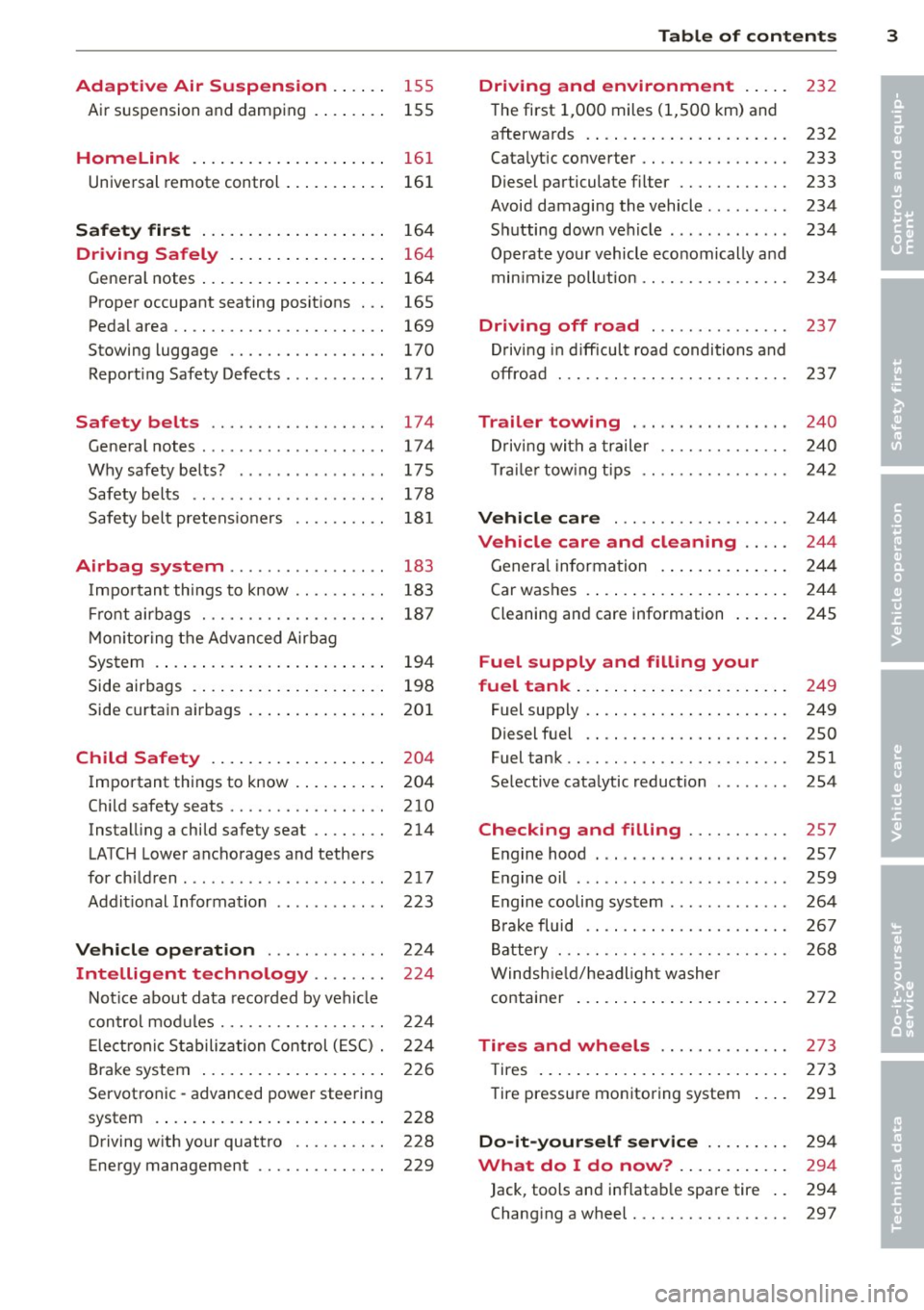
Adaptive Air Suspension .. .. . .
Air suspension and damping 155
155
Homelink . . . . . . . . . . . . . . . . . . . . . 161
Universal remote control . . . . . . . . . . . 161
Safety first . . . . . . . . . . . . . . . . . . . . 164
Driving Safely . . . . . . . . . . . . . . . . . 164
General notes ................... .
Proper occupant seating positions . . .
Pedal area .. .. ............. .. .. . .
Stowing luggage ......... .... .. . .
Reporting Safety Defects ....... ... .
Safety belts ............... .. . .
General notes ......... ...... .... .
Why safety belts? ........... .... .
Safety belts ..... .. ...... .. .. .. . .
Safety belt pretensioners .. .. .. .. . .
Airbag system .......... ... ... .
Important things to know .... .. .. . .
Front airbags ................ .. . .
Monitoring the Advanced Airbag
System .... .. .............. ... . .
Side airbags ................ ... . .
Side curtain airbags .......... ... . .
Child Safety ................. . .
Important things to know ........ . .
Child safety seats ......... .... .. . .
Installing a child safety seat .. .. .. . .
LATCH Lower anchorages and tethers
for children .... .. .. ...... .. .. .. . .
Additional Information
Vehicle operation ....... .. .. . .
Intelligent technology .. .. . .. .
164
165
169
170
171
174 174
175
178
181
183
183
187
194
198
201
204
204
210
214
217
223
224
224
Notice about data recorded by vehicle
control modules . . . . . . . . . . . . . . . . . . 224
Electronic Stabilization Control (ESC) . 224
Brake system . . . . . . . . . . . . . . . . . . . . 226
Servotronic -advanced power steering
system . . . . . . . . . . . . . . . . . . . . . . . . . 228
Driving with your quattro . . . . . . . . . . 228
Energy management . . . . . . . . . . . . . . 229
Table of contents 3
Driving and environment . . . . .
232
The first 1,000 miles (1,500 km) and
afterwards . . . . . . . . . . . . . . . . . . . . . . 232
Catalytic converter . . . . . . . . . . . . . . . . 233
Diesel particulate filter . . . . . . . . . . . . 233
Avoid damaging the vehicle . . . . . . . . . 234
Shutting down vehicle . . . . . . . . . . . . . 234
Operate your vehicle economically and
min imize pollution .. . ............ .
Driving off road .............. .
Driving in difficult road conditions and
offroad . .. .. .. .. .... ........... .
Trailer towing .... .. .. ... ..... .
Driving with a trailer ........... .. .
Trailer towing tips .. . ............ .
Vehicle care ... .. .. ........... .
Vehicle care and cleaning .... .
General information ............. .
Car washes . ....... ............. .
Cleaning and care information ..... .
Fuel supply and filling your
fuel tank ... .... .. ............. .
Fuel supply . ... .. .. ............. .
Diesel fuel .. .. ...... ........... .
Fuel tank .. .. .. .. ... ............ .
Selective catalytic reduction ....... .
Checking and filling .......... .
Engine hood ..... .... .... ... .... .
Engine oil ... .. .. .. . .. .... ...... .
Engine cooling system ............ .
Brake fluid .. .. .. ............... .
Battery ..... .. .. .. .. ........... .
Windshield/headlight washer 234
237
237
240
240
242
244
244
244
244
245
249
249
250
251
254
257
257
259
264
267
268
container . . . . . . . . . . . . . . . . . . . . . . . 272
Tires and wheels . . . . . . . . . . . . . . 273
T ires . . . . . . . . . . . . . . . . . . . . . . . . . . . 273
Tire pressure monitoring system 291
Do-it-yourself service . . . . . . . . . 294
What do I do now? . . . . . . . . . . . . 294
Jack, tools and inflatable spare tire . . 294
Changing a wheel . . . . . . . . . . . . . . . . . 297
•
•
Page 16 of 340
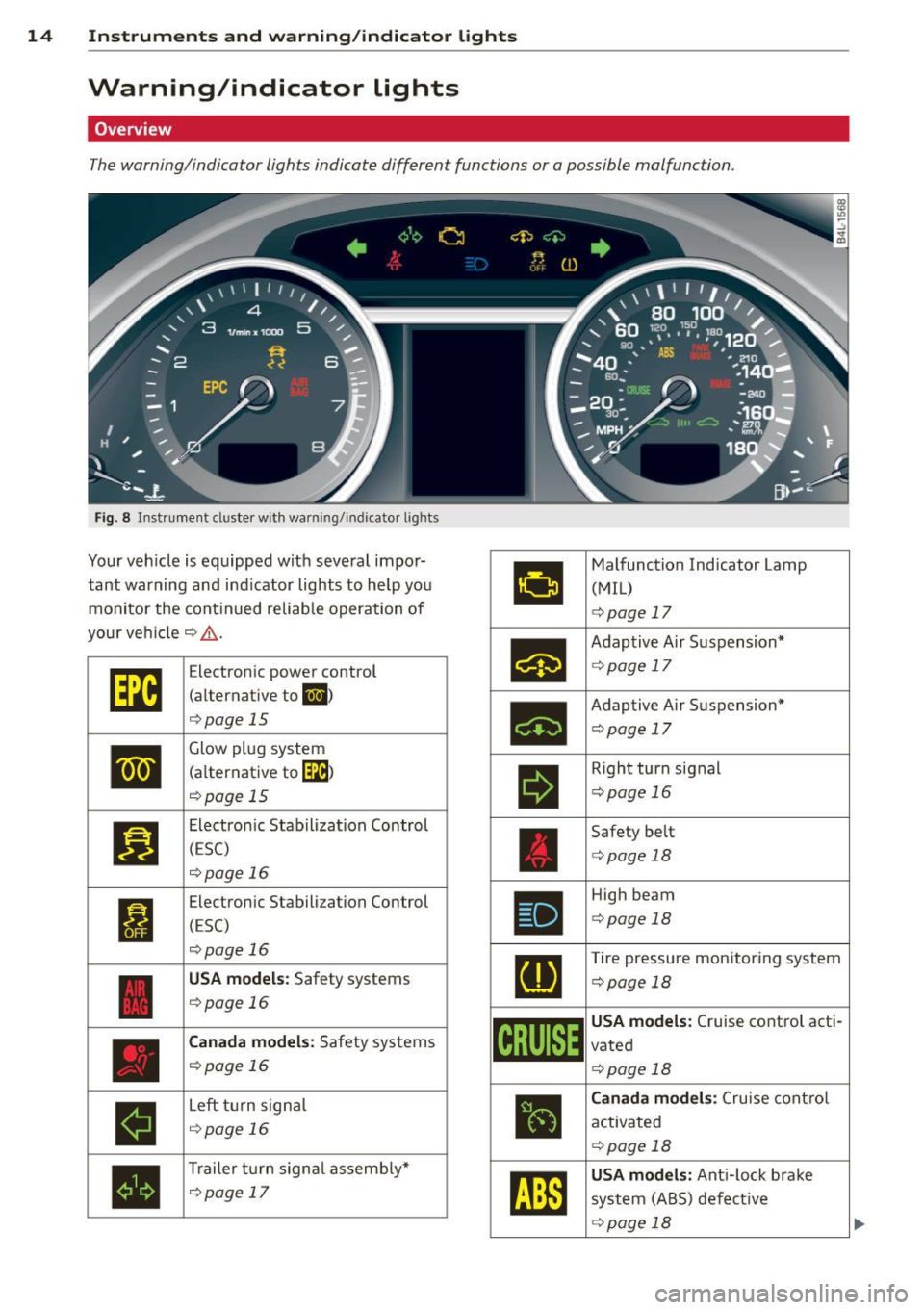
14 Instruments and warning/indicator lights
Warning/indicator lights
Overview
The warning/indicator lights indicate different functions or a possible malfunction.
Fig . 8 Instrument duster w ith warning/indicator ligh ts
Your veh icle is equipped with several impor·
tant warning and indicator lights to help you
monitor the continued reliable operation of
your vehicle¢ _&.
•
II
•
Electron ic power control
(alternative to
II)
¢page 15
Glow plug system
(a lternative to
[3B)
¢page 15
Electronic Stabilization Control
(ESC)
¢page 16
Electronic Stabilization Control
(ESC)
¢page 16
USA models: Safety systems
¢page 16
Canada models: Safety systems
¢page 16
Left turn signa l
¢page 16
Trailer turn signa l assembly*
¢page 17
•
Malfunction Indicator Lamp
(MIL)
¢ page 17
•
Adaptive Air Suspension*
c:>page 17
•
Adaptive A ir Suspension*
¢pag e 17
II
Right turn signal
¢page 16
Safety belt
c:>page 18
Ill
High beam
c:>page 18
[I]
Tire pressure monitoring system
c:>page 18
~i[~~1~
USA models: Cruise control acti·
vated
c:>page 18
•
Canada models: Cruise contro l
activated
c:>page 18
rm
USA models: Anti-lock brake
system (ABS) defective
¢ page 18
Page 20 of 340
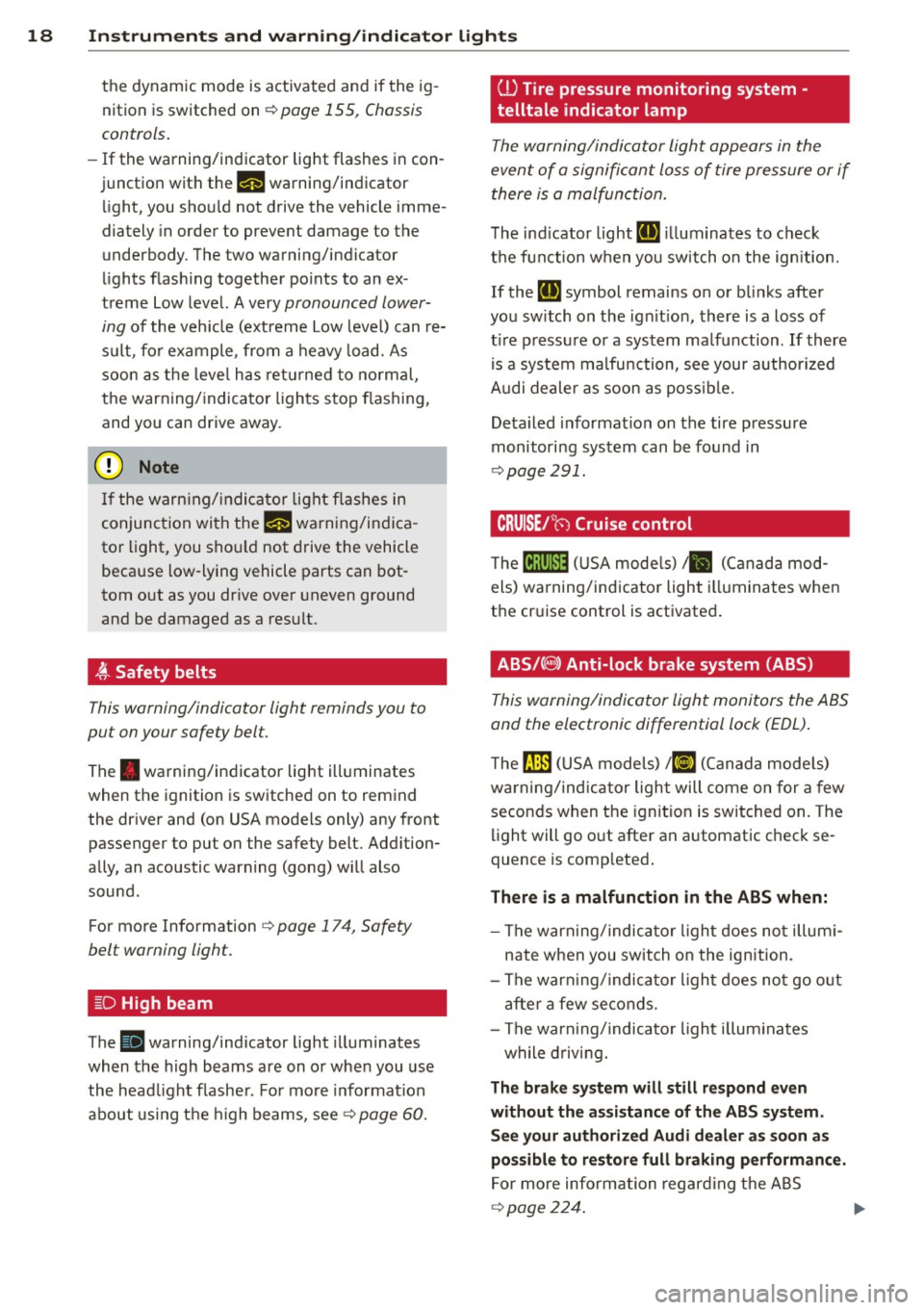
18 Instruments and warning/indicator lights
the dynamic mode is activated and if the ig
nition is switched on¢
page 155, Chassis
controls .
-If the warning/indicator light flashes in con
junction with the
IIJ warning/indicator
li ght, you shou ld not drive the vehicle imme
diately in order to prevent damage to the
underbody . The two warning/indicator
lights flashing together points to an ex
treme Low level. A very
pronounced lower
ing
of the veh icle (ext reme Low level) can re
sult, for example, from a heavy load. As
soon as the level has ret ur ned to normal
I
the warning/indicator lights stop flashing,
and yo u can drive away.
{[) Note
If the warn ing/ ind icator light flashes in
conjunction with the
IIJ warning/indica
tor light, you should not drive the vehicle
because low-lying vehicle parts can bot
tom out as you drive over uneven ground
and be damaged as a result.
~ Safety belts
This warning/indicator light reminds you to
put on your safety belt.
The . warning/indicator light illuminates
when the ignition is switched on to remind
the driver and (on USA models only) any front passenger to put on the safety belt. Add ition
ally, an acoustic warning (gong) w ill also
sound.
For more Information
¢ page 17 4, Safety
belt warning light.
~D High beam
The II warning/indicator light illuminates
when the high beams are on or whe n you use
the head light flasher . For more informat ion
about using the high beams, see¢
page 60.
ill Tire pressure monitoring system -
telltale indicator lamp
The warning/indicator light appears in the
event of a significant loss of tire pressure or if
there is a malfunction.
The indicator light [D] ill uminates to check
the function when you switch on the ignition.
If the
[D] symbol remains on or blinks after
you sw itch on the ign it ion, there is a loss of
t ir e p ressure or a system malfunction . If there
is a system malfunction, see your authorized
Audi dealer as soon as possible.
Detailed informat ion on the tire pressure
monitoring system can be found in
¢page 291.
. CRUISE /''(") Cruise control
The lij;(l )~i~ (USA mode ls) ,11 (Canada mod
els) warning/indicator light illuminates when
t h e cruise control is activated .
ABS/(8) Anti-lock brake system (ABS)
This warning/indicator light monitors the ABS
and the electronic differential lock (EDL) .
The ~ (USA models) 1(1] (Canada models)
warning/indicator light will come on for a few
seconds when the ignition is switched on. The
lig ht will go out after an automatic check se
quence is comp leted .
There is a malfunction in the ABS when:
-The warning/indicator light does not illumi
nate when you switch o n the ignition.
- The warning/indicator light does not go out
after a few seconds.
- The warning/indicator light illum inates
while driving.
The brake system will still respond even
without the assistance of the ABS system.
See your authorized Audi dealer as soon as
possible to restore full braking performance.
For more information regarding the ABS
¢page 224. II>-
Page 23 of 340

Driver information
display
Introduction
General notes
The driver information display inside the in
strument cluster provides you, the driver ,
with much useful information .
Fig. 9 In st ru men t cl uster: ce nte r dis p lay
Info rmation from the Drive r Information Sys
tem is shown in the display in the center of
t he instrument cl uster .
When you turn on the ignition and while you
are driving, some functions and vehicle com ponents are scanned fo r their operating sta
t us. Malfunc tions or required service proce
dures are signal led aud ibly and shown by red
and yellow lighted symbols and rem inders to
the dr iver in the display.
T he driver i s also shown information abou t ra
d io and CD operation and directions for the
nav igation system . You can f ind additional in
formation on these subjects in the MMI man
ua l.
The Driver Information System prov ides the
following functions:
Sound system disp lay ¢
page 21
Outside air temperature ¢page 22
Digital speedometer ¢
page 22
Door open indicator ¢page 22
D efective light b ulb ¢
poge23
Serv ice i nte rval display ¢page 23
Auto Check system ¢
page 30
Driver information ¢
page 30
Driver inform ation di spl ay 21
Speed warning system ¢page28
T rip computer ¢
page24
Cruise con trol ¢page 111
Adapt ive cruise control* ¢
page 113
Selector lever pos ition ¢page 137
Adapt ive Air Suspension * i=>
page 158
Tire pressure monitoring ¢page 291
(D Tips
In the event of a malfunction either a red
or yellow icon appears in the display . Red
symbols indicate
Dang er ¢ page 31 . Yel
l ow symbo ls indicate a
Warning
¢ page 34.
Sound system display
Fig. 10 D isp lay: so un d syste m
If priority 1 or pr iority 2 faults are not shown
by the Auto Check Control, the name of the ra
dio station you are tuned to or t he frequency
and the recept ion range are shown in the up
per area of the d isplay.
When the CD is in use, the tit le of the track
being played is shown . T he number of the CD
(CDI to CD6) cur rently be ing played is also
shown.
Page 37 of 340
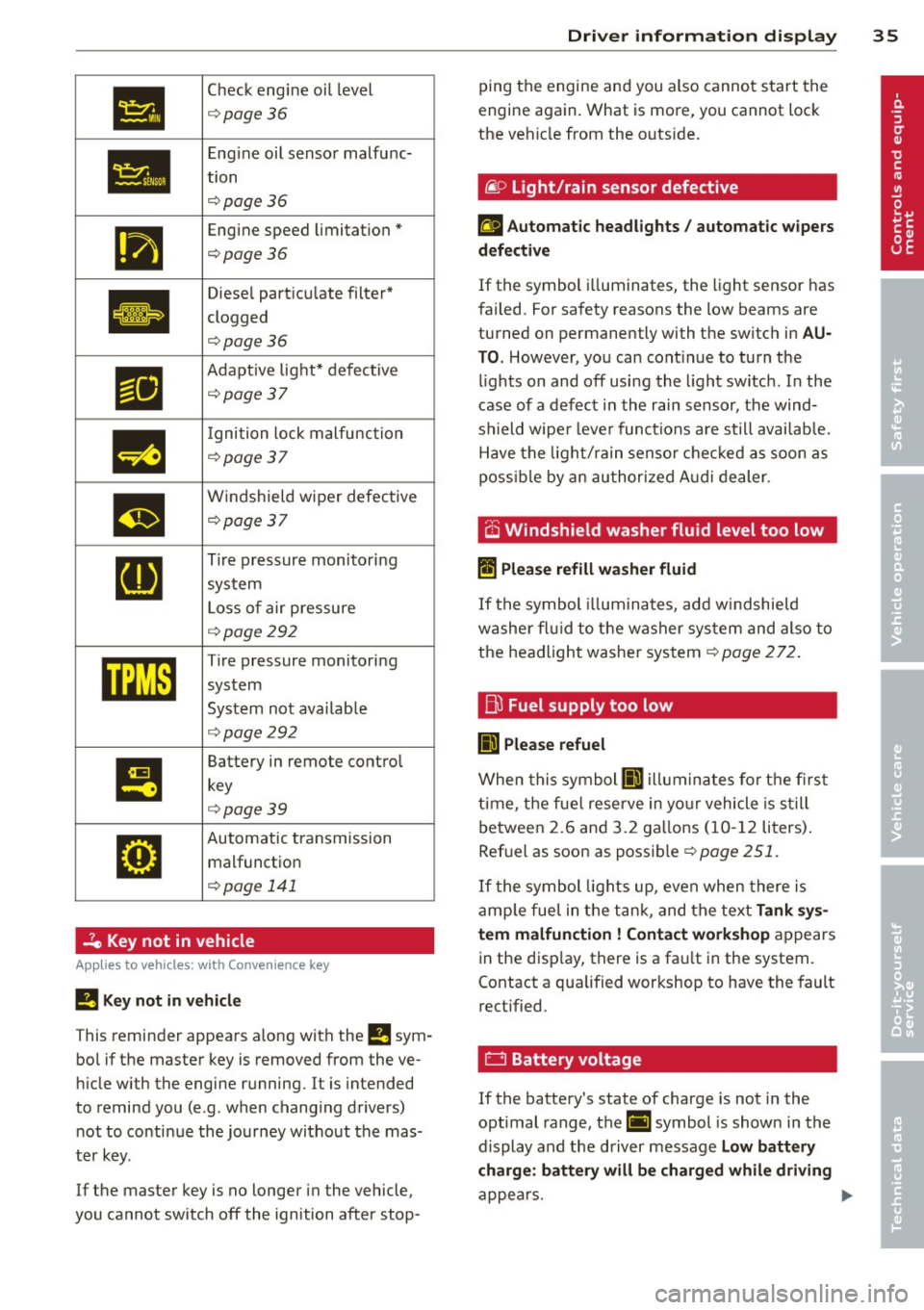
•
Check engine oi l level
¢ page36
•
Engine oil sensor malfunc-
tion
¢page 36
111
Engine speed limitation*
¢page36
Ill
Diesel particu late filter*
clogged
.
¢page36
Ill
Adapt ive light* defective
¢page37
m
I gnition lock malfunction
¢page 37
m
Windshield wiper defective
¢page37
[I]
Tire pressure monitoring
system
L oss of air pressure
¢ page292
mm
Tire pressure monitoring
system
System not avai lab le
¢ page292
I!
Battery in remote contro l
key
¢page39
•
Automatic transmission malfunction
¢ page 141
2e Key not in vehicle
Applies to vehicles: with Convenience key
!I Key not in ve hicle
This reminder appears a long with the !I sym
bo l if the master key is removed from the ve
hi cle with the engine running.
It is intended
to remind you (e.g. when changing drivers) not to continue the journey w ithout the mas
ter key.
If the master key is no longer in the vehicle,
you cannot sw itch
off the ignition after stop-
Dri ver information di spla y 35
ping the engine and you also cannot start the
engine again. What is more, you cannot lock
the ve hicle from the outs ide .
liP Light/rain sensor defective
£I Automatic headlights / automatic w ipers
d efe ctiv e
If the symbol i lluminates, the light sensor has
failed. For safety reasons the low beams are
turned on permanently with the switch in
AU
T O . However, you can cont inue to turn the
l ights on and
off using the l ight sw itch. In the
case of a defect in the rain sensor, the wind
shield wipe r lever functions a re still availab le.
Have the light/ rain senso r chec ked as soon as
poss ib le by an au thorized A udi dealer .
.-v ~,
O Windshield washer fluid level too low
II Plea se refill wa she r fluid
If the symbol illum ina tes, add w indshie ld
washe r fl ui d to the washer sys tem and also to
the headlight washer system¢
page 272.
fj)
Fuel supply too low
II) Ple ase refuel
When this symbol II) illuminates for the first
t ime, the fue l reserve in yo ur vehicle is s till
between 2.6 and 3.2 ga llons (10- 12 liters).
Ref uel as soon as possible¢
page 251.
If the symbol lights up, even when there is
amp le fue l in the tank, and the text
Tank sy s
tem malfuncti on! Contact work shop
appears
in the disp lay, there is a fa ult in the system.
Contact a qualified workshop to have the fault
rect ified.
0 Battery voltage
If the battery's state of charge is not in the
optimal range, the(•] symbol is shown in the
display and the driver message
Low battery
charge : batt ery will be char ged whil e driving
appea rs. .,.
Page 166 of 340
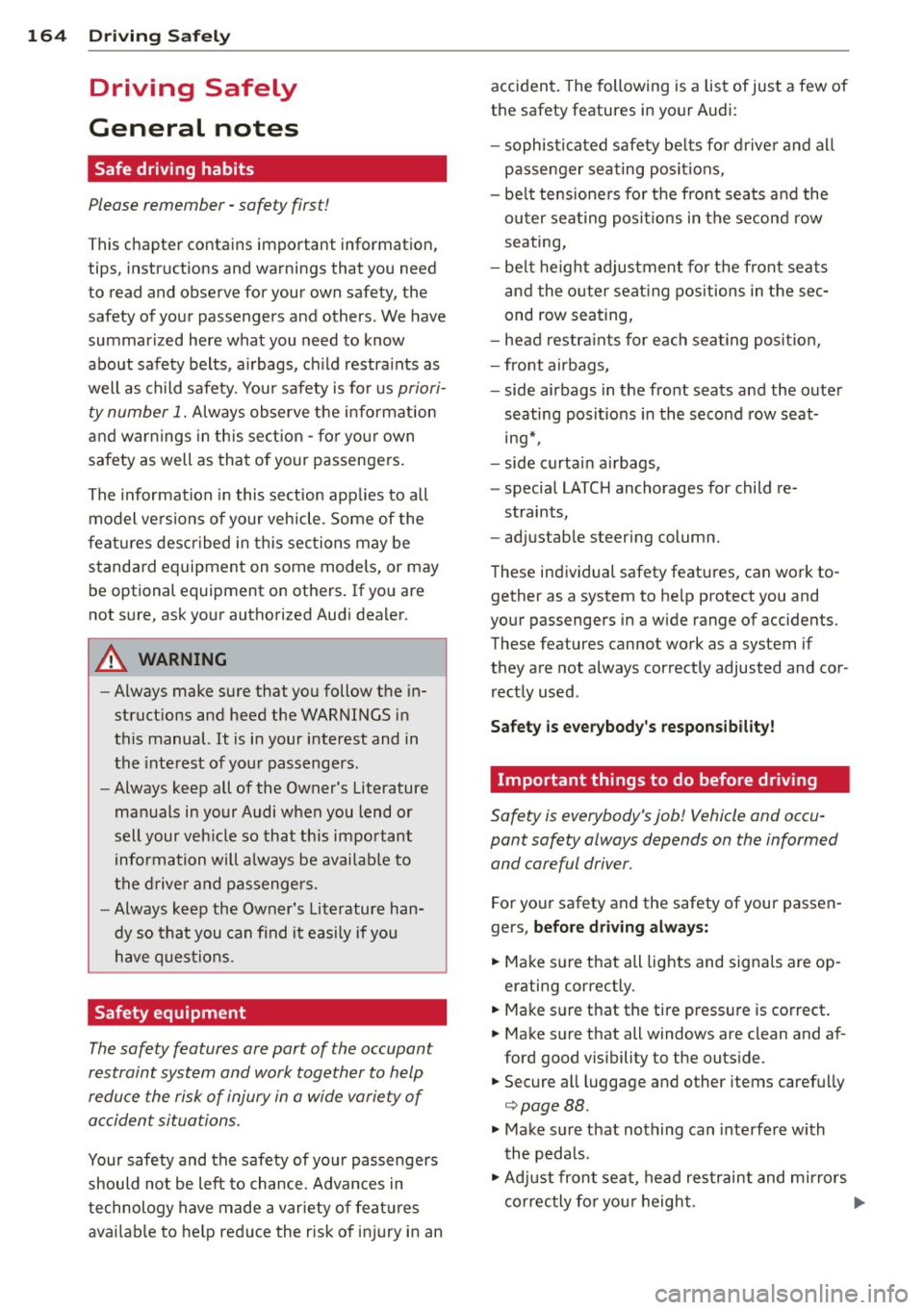
164 Driving Safel y
Driving Safely
General notes
Safe driving habits
Please remember -safety first!
This chapter contains important information,
tips, instructions and warnings that you need
to read and observe for your own safety, the
safety of your passengers and others . We have
summarized here what you need to know
about safety belts, a irbags, ch ild restra ints as
well as child safety. Your safety is for us
priori
ty number 1.
Always observe the info rmat ion
and warn ings in th is sect ion -fo r yo ur own
safety as well as that of your passengers .
The information in this se ction app lies to all
model ve rsions of your veh icle . Some of the
feat ures desc ribed in this sec tions may be
standard equipment on some models, or may
be optional equipment on others . If you are
not sure, ask your authorized Aud i dealer.
A WARNING
- Always make sure that you follow the in
struct ions and heed the WARNINGS in
this manual. It is in your interest and in
the inte rest of you r passengers.
- Always keep all of the Owner's Literature
man uals in your Audi when you lend or
sell your veh icle so that this impo rtant
information will a lways be availab le to
the drive r and pas sengers.
- Always keep the Owner's Literature han
dy so tha t you can find it easily if yo u
have ques tions.
Safety equipment
The safety features are part of the occupant
restraint system and work together to help
redu ce the risk of injury in a wide variety of
accident situations.
Your safety and the safety of you r passenge rs
should not be left to chance. Advances in
technology have made a varie ty o f fea tures
avai la bl e to he lp re duce the risk of inj ury in an accident
. The following is a list of just a few of
the safety features in your Audi:
- sophis tic ated s afety be lts for d rive r and a ll
passenger sea ting pos it ions,
- be lt te nsione rs fo r th e fro nt sea ts a nd the
ou ter sea ting posit ions in the second row
seating,
- be lt h eight adjustment fo r th e front sea ts
an d the o ute r seat ing pos itions in the sec
ond row seating,
- he ad restra ints for e ach sea ting pos ition,
- fro nt airbags,
- side airbags in the fro nt seats and the outer
seating positions in the second row seat ing*,
- side curta in ai rbags,
- specia l LATCH anchorages for child re-
st raints,
- ad justab le steering colum n.
These individual safety features, can work to gether as a system to he lp protect you and
your passengers in a wide range of accidents .
These features cannot work as a system if
they are not always correctly adjusted and cor rectly used .
Safety is everybody's responsibil ity!
Important things to do before driving
Safety is everybody 's job! Vehicle and occu
pant safety always depends on the informed
and careful driver.
Fo r yo ur safety and the safety of your passen
gers,
before driving always:
.. Ma ke s ure t hat all lights and sign als are op
erati ng correctly .
.. Make s ure t hat the tire pressure is correct.
.. Make s ure that all windows are clean and af
ford good vis ibility to the outs ide.
.. Secure all luggage and other items carefu lly
¢ page 88.
.. Make s ure that nothing can inte rfere with
the peda ls.
.. Adj ust fron t seat, head restraint and m irrors
correc tly fo r you r height . .,.
Page 173 of 340
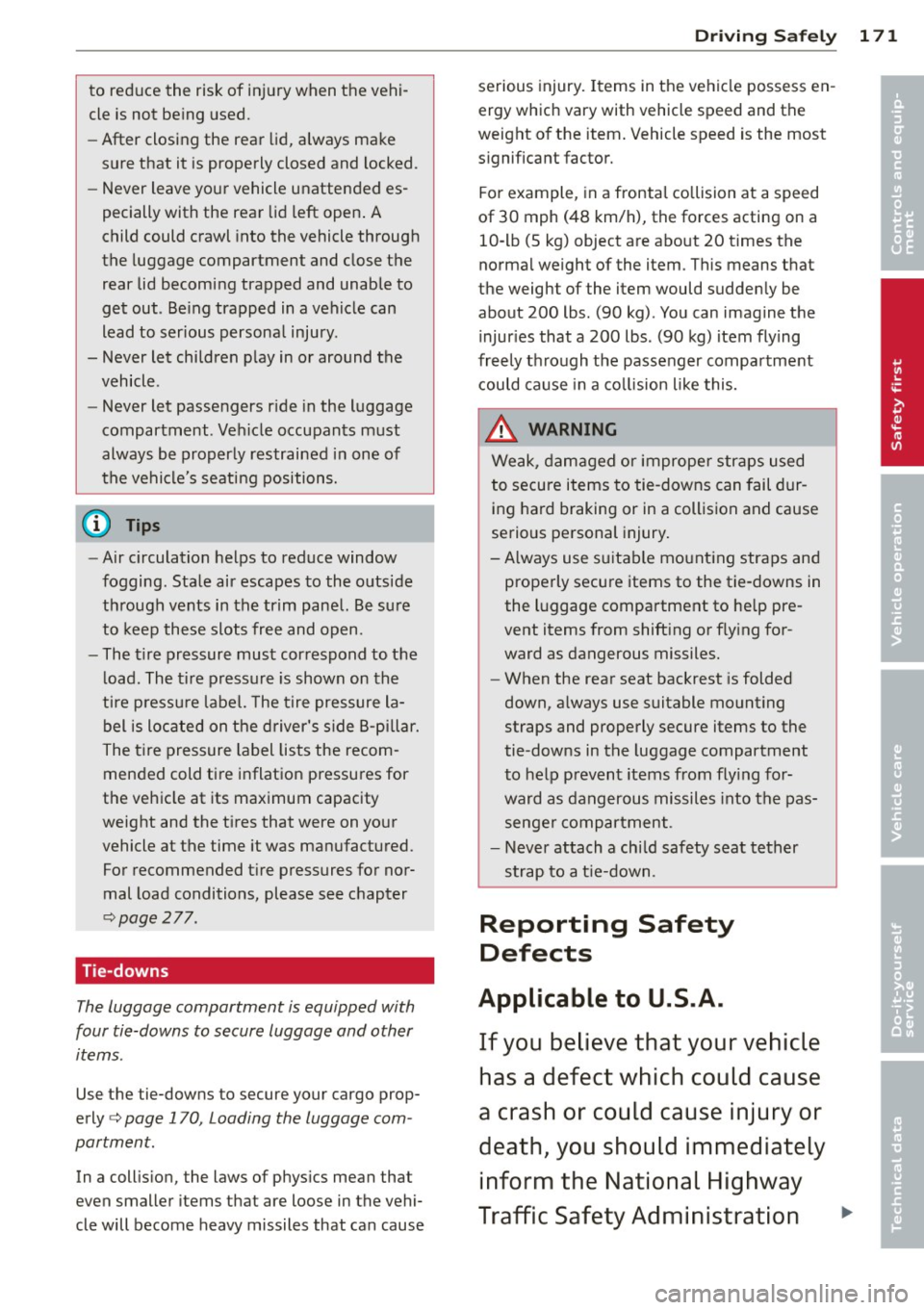
to reduce the risk of inj ury when the vehi
cle is not be ing used.
- After closing the rear lid, always make
sure that it is properly closed and locked.
- Never leave your vehicle unattended es
pecially with the rear lid left open . A
child could crawl into the vehicle through
the luggage compartment and close the
rear lid becoming trapped and unable to
get out . Be ing trapped in a vehicle can
lead to serious persona l injury .
- Never let children play in or around the vehicle .
- Never let passengers r ide in the luggage
compartment . Veh icle occupants must
always be properly restrained in one of
the vehicle's seating positions.
(D Tips
- Air c irculation helps to reduce window
fogging . Sta le air escapes to the outside
th rough vents in the trim pane l. Be sure
to keep these slots free and open .
-The t ire pressure must correspond to the
load. The t ire pressure is shown on the
tire p ress ure label. The tire pressure la
bel is located on the d river's s ide B-pi llar.
The t ire pressure label lists the recom
mended cold tire inflat ion pressures for
the vehicle at its maximum capacity
weight and the tires that were on your
vehicle at the time it was manufactured .
For recommended t ire pressures for nor
mal load conditions, please see chapter
c:> page277 .
Tie-downs
The luggage compartment is equipped with
four tie-downs to secure luggage and other
items .
Use the tie-downs to secure your cargo prop
erly
c:> page 1 70, Loading the luggage com
partment.
In a coll is ion, the l aws of phys ics mean that
even smaller items that are loose in the vehi
cle will become heavy missiles that can cause
Dr iving S afel y 171
serious injury. Items in the veh icle possess en
ergy which vary with vehicle speed and th e
weight of the item . Vehicle speed is the most
s ignificant factor.
For example, in a fronta l collision at a speed
of 30 mph (48 km/h), the forces acting on a
10 -lb (5 kg) object are about 20 times the
normal weight of the item. This means th at
the weigh t of the item would suddenly be
about 200 lbs. (90 kg) . You can imagine the
i njur ies that a 200 lbs . (90 kg) item flying
freely th rough the passenger compartment
could cause in a co llision like this.
A WARNING
Weak, damaged or improper straps used
to secure items to tie-downs can fail dur
ing hard braking or in a collision and cause
serious personal injury.
-Always use s uitable mount ing straps and
properly secu re items to the tie-downs in
the l uggage compartment to he lp pre
vent items from shift ing or f lying fo r
ward as dangerous missiles.
- When the rear seat backrest is folded
down, a lways use suitable mounting
straps and properly secure items to the
tie-downs in the luggage compartment
to help p revent items from fly ing for
ward as dangerous missiles into the pas
senger compartment .
- Never attach a chi ld safety seat tether
strap to a t ie-down .
Reporting Safety
Defects
Applicable to U.S.A.
If yo u b elieve that your vehicle
ha s a defec t w hi ch could cau se
a c rash or co uld cause i njur y or
d ea th, you sh ould imm ediat ely
inform th e National Hi ghwa y
Tr affi c Sa fet y Admini strati on ..,.
•
•
Page 229 of 340
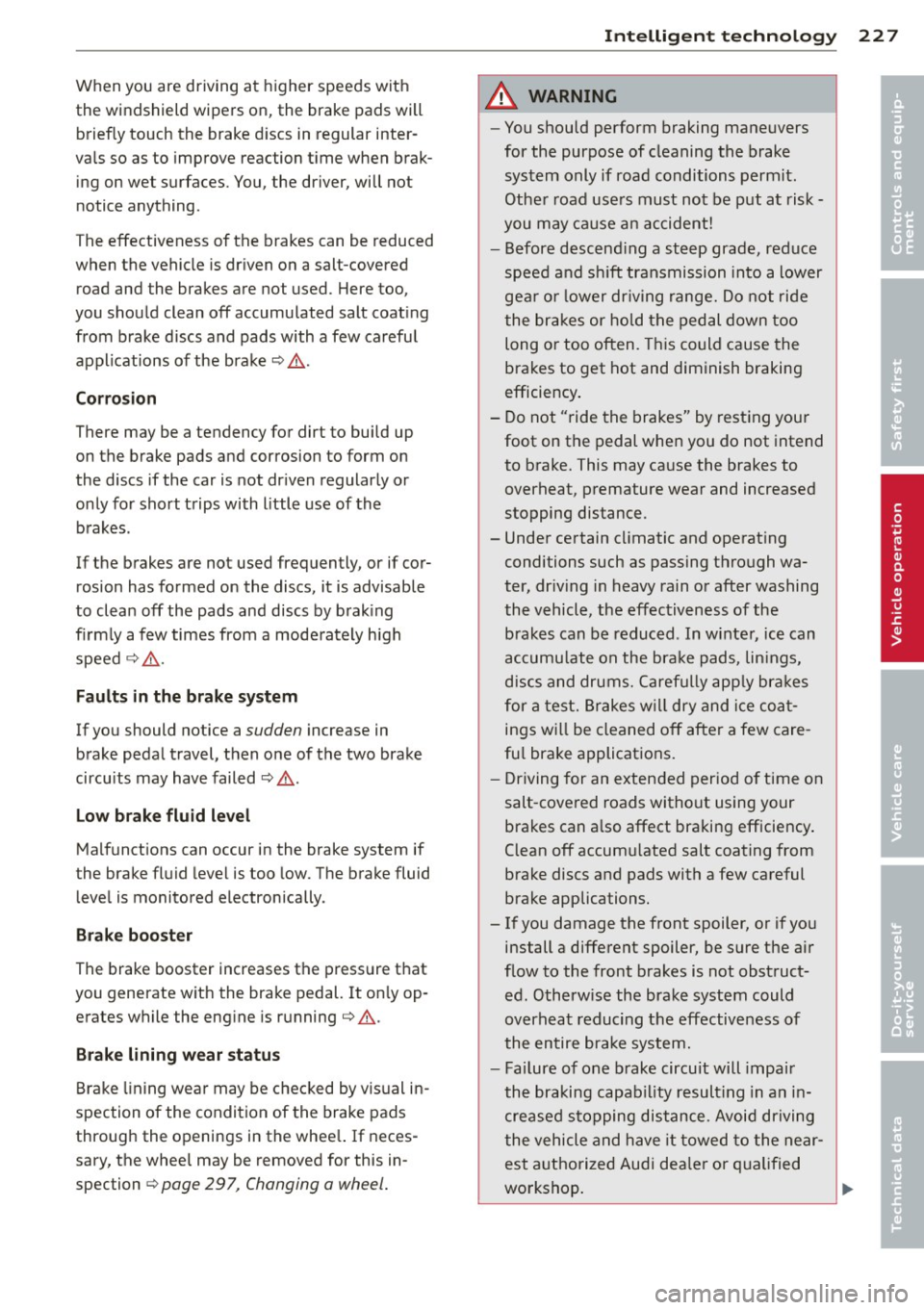
When you are driving at higher speeds wit h
the windshield wipers on, the brake pads will briefly touch the brake d iscs in regular inter
vals so as to improve reaction t ime when brak
ing on wet surfaces. You, the driver, will not
notice anything .
The effectiveness of the brakes can be reduced
when the vehicle is driven on a salt-covered
road and the brakes are not used . Here too,
you should clean
off accumulated salt coat ing
from brake discs and pads with a few careful
applications of the brake ¢ & .
Cor ro sion
There may be a tendency for dirt to build up
on the brake pads and corrosion to form on
the discs if the car is not dr iven regularly or
only for sho rt trips with little use of the
b rakes .
If the brakes are not used frequently, or if cor rosion has formed on the discs, it is advisable
to clean
off the pads and discs by b rak ing
fi rm ly a few times from a mode rately h igh
speed ¢.& .
Faults in the brake system
If you should notice a sudden increase in
brake peda l travel, t hen one of the two brake
circu its may have failed¢& .
Low brake flu id le vel
Malfunct ions can occur in the brake system if
the brake fl uid level is too low . T he brake fluid
level is monitored electronically .
Brake booste r
The brake booster increases the pressure t hat
you generate w ith the bra ke pedal. It on ly op
erates while the eng ine is running¢ &.
Brake lining wear statu s
Brake lining wea r may be c hecked by vis ual in
spection of the condition of the brake pads
through the openings in the whee l. If neces
sary, the whee l may be removed for this in
spection ¢
page 297, Changing a wheel.
Intellig ent technolog y 22 7
A WARNING
-You should perform braking maneuvers
for the purpose of cleaning the brake
system only if road conditions permit.
Othe r road use rs must not be put at risk -
you may ca use an accident!
- Before descend ing a steep grade, reduce
speed a nd s hift transmission into a lower
gea r o r l ower dr iving range. Do not ride
the br akes or ho ld t he pedal down too
long o r too often. This could cause the
brakes to get hot and diminish braking
efficiency .
- Do not " ride the brakes" by rest ing you r
foot on the pedal when you do not intend
to brake. This may ca use the brakes to
overheat, premature wear and increased
stopping distance .
- Under certain cl imatic and ope rat ing
conditions such as passing thro ugh wa
ter , dr iv ing in heavy rain o r after washing
the vehicle , the effectiveness of the
brakes can be reduced . In winte r, ice can
accumu late on the bra ke pads, lin ings,
d iscs a nd drum s. Carefu lly app ly bra ke s
for a test. Brakes w ill dry and ice co at
ings w ill be cleaned
off after a few care
fu l brake applicat ions.
- Driving for an exten ded period o f time o n
salt -cove red roads without using your
brakes can a lso affect braking efficiency .
C lean
off accum ulated salt coating from
brake discs and pads with a few careful
brake applications.
- I f you damage the front spoiler, o r if you
install a different spoiler, be sure the air
f low to the front brakes is not obstruct
ed. Otherw ise the brak e system could
overheat reducing the effectiveness of
the entire brake system.
- Failure of one b rake circuit will impai r
the braking capab ility result ing in an in
creased s topping distance. Avoid driving
the vehicle a nd have it towed to the ne ar
est a uthorized Audi dea le r or qu alified
wo rkshop.
•
•
Page 243 of 340
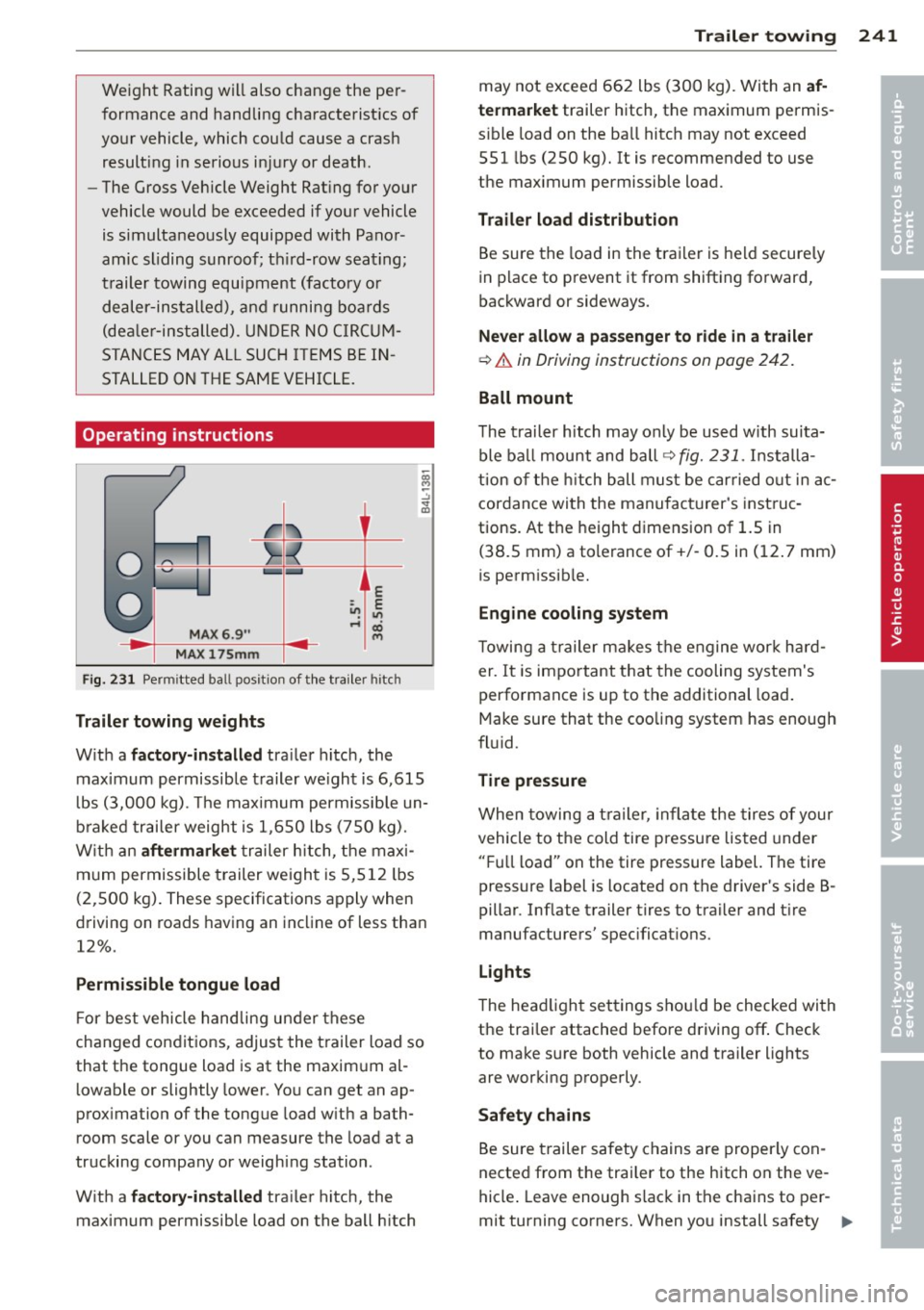
Weight Rating will also change the per
formance and handling characteristics of
your vehicle, which could cause a crash resulting in serious injury or death .
- The Gross Vehicle Weight Rating for your
vehicle would be exceeded if your vehicle
is simultaneously equipped with Panor
amic sliding sunroof; third-row seating;
trailer towing equipment (factory or
dealer-installed), and running boards
(dealer-installed) . UNDER NO CIRCUM
STANCES MAY ALL SUCH ITEMS BE IN
STALLED ON THE SAME VEHICLE.
Operating instructions
MAX 6.9"
MAX175mm
E
1/1 E 1/1 ... a)
m
Fig. 231 Perm itted ba ll posit ion of the trailer hitch
Trailer towing weights
With a factory-installed trailer hitch, the
maximum permissible trailer weight is 6,615
lbs (3,000 kg). The maximum permissible un
braked trailer weight is 1,650 lbs (750 kg).
With an
aftermarket trailer hitch, the maxi
mum permissible trailer weight is 5,512 lbs
(2,500 kg). These specifications apply when
driving on roads having an incline of less than
12%.
Permissible tongue load
For best vehicle handling under these
changed cond itions, adjust the trailer load so
that the tongue load is at the maximum al
lowable or slightly lower. You can get an ap
proximation of the tongue load with a bath
room scale or you can measure the load at a
trucking company or weighing station .
With a
factory-installed trailer hitch, the
maximum permissible load on the ball hitch Trailer towing 241
may not exceed 662 lbs (300 kg). With an
af
termarket
trailer hitch, the maximum permis
sible load on the ball hitch may not exceed
551 lbs (250 kg).
It is recommended to use
the maximum permissible load.
Trailer load distribution
Be sure the load in the trailer is held securely
in place to prevent it from shifting forward,
backward or sideways.
Never allow a passenger to ride in a trailer
¢ .& in Driving instructions on page 242.
Ball mount
The trailer hitch may only be used with suita
ble ball mount and ball ¢
fig. 231. Installa
tion of the hitch ball must be carried out in ac
cordance with the manufacturer's instruc
tions. At the height dimension of 1.5 in
(38.S mm) a tolerance of+/- 0.5 in (12. 7 mm)
is permissible.
Engine cooling system
Towing a trailer makes the engine work hard
er . It is important that the cooling system's
performance is up to the additional load.
Make sure that the cooling system has enough
fluid .
Tire pressure
When towing a trailer, inflate the tires of your
vehicle to the cold tire pressure listed under
"Full load" on the tire pressure label. The tire
pressure label is located on the driver's side B
pillar . Inflate trailer tires to trailer and tire
manufacturers' specifications .
Lights
The headlight settings should be checked with
the trailer attached before driving
off. Check
to make sure both vehicle and trailer lights
are working properly .
Safety chains
Be sure trailer safety chains are properly con
nected from the trailer to the hitch on the
ve
hicle. Leave enough slack in the chains to per
mit turning corners. When you install safety
Ill-
•
•
Page 246 of 340
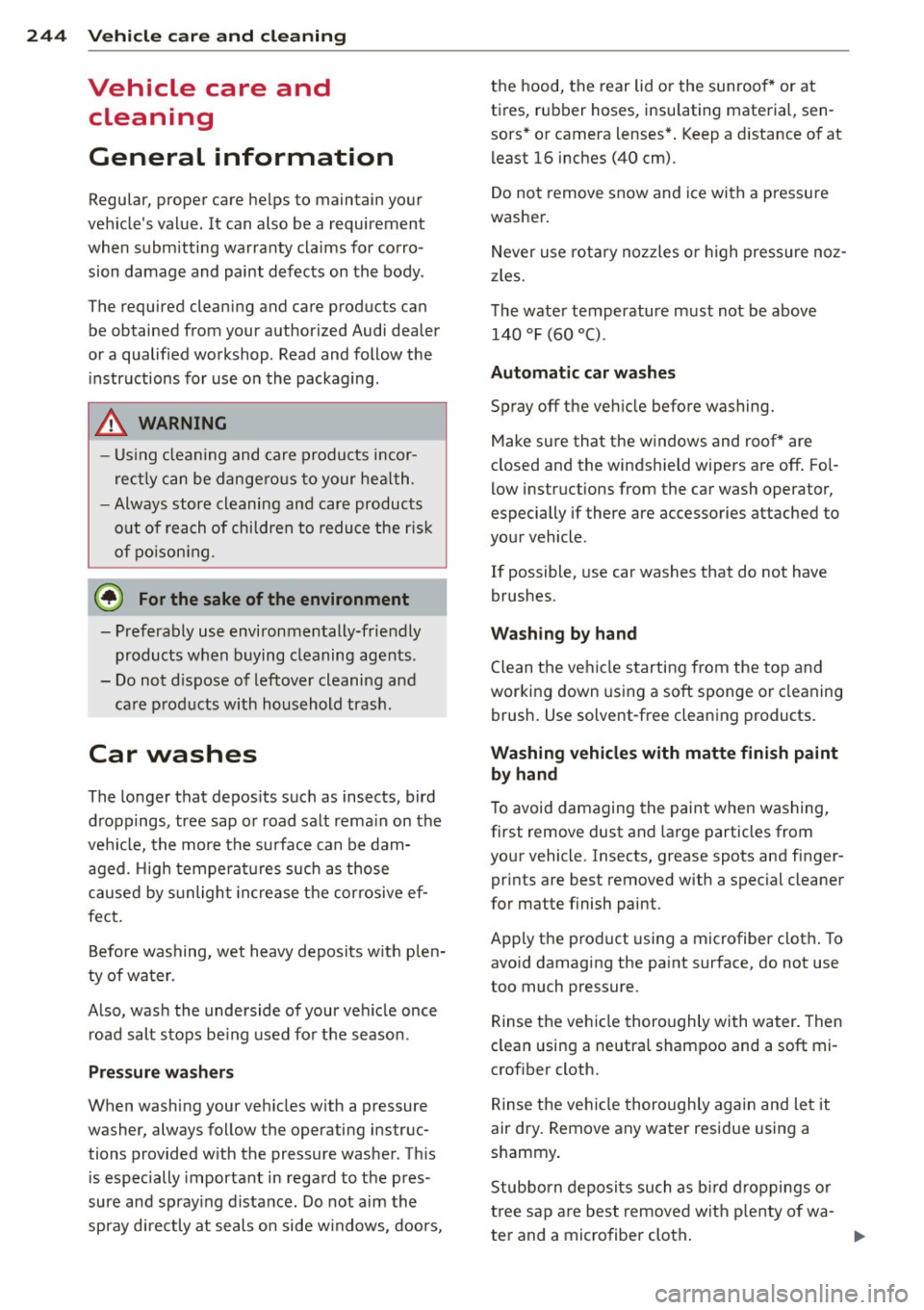
24 4 Vehicle care and cleaning
Vehicle care and
cleaning
General information
Regular, proper care helps to maintain your
vehicle 's value. It can also be a requirement
when subm itting warranty claims for corro
sion damage and paint defects on the body .
The required cleaning and care products can be obtained from your authorized Audi dealer
or a qualified workshop. Read and follow the
instructions for use on the packaging .
A WARNING
-Us ing cleaning and care products incor
rect ly can be dange rous to your hea lth .
- Always store cleaning and care products
o ut of reach of children to reduce the r is k
of po ison ing.
@) For the sake of the environment
- Preferably use environmentally-friendly
products when buying cleaning agents .
- Do not d ispose of leftover cleaning and
ca re p rod ucts with household trash .
Car washes
-
The longer that depos its such as insects, bird
droppings , tree sap o r road salt rema in on the
ve hicle, the more the surface can be dam
aged. High tempera tures such as those
caused by s unligh t increase the corrosive ef
fect.
B efore washing, wet heavy deposits w ith p le n
ty of water.
A lso, wash the underside of your vehicle once
road salt stops be ing used fo r the season .
Pressure wa sher s
When washing your vehicles w ith a pressure
washer, always follow the operating instruc
tions provided w ith the pressure washer. Th is
is especially important in rega rd to the pres
sure and spray ing distance . Do not aim the
spray d irectly at seals o n side w indows, doors, the hood, the
rear lid o r the sunroof * or at
tires, rubber hoses, insu lating material, sen
sors * or camera lenses* . Keep a d istance of at
l east 16 inches (40 cm).
Do not remove snow and ice with a pressu re
washer .
Never use rota ry no zzles or high pressure noz
z les.
T he water temperature must not be above
140
°F (60 °() .
Automatic car washes
Spray off the ve hicle before washing.
Make sure that the windows and roof * are
closed and the winds hield wipers are off . Fo l
l ow instructions from the car wash operator,
especially if there are accessories attached to
your vehicle.
If possible, use car washes that do not have
brushes .
Washing by hand
Clean the ve hicl e starting from the top and
working down using a soft sponge or cleaning
brush . Use solvent-free cleaning products.
Washing vehicles with matte finish paint
by hand
T o avoid damaging the paint when washing,
first remove dust and la rge particles from
your vehicle. Insects, grease spots and finger
prints are best removed with a special cleaner
for matte finish paint .
Apply the prod uct us ing a microfiber cloth . To
avo id damaging the pa int surface, do not use
too much pressure.
Rinse the vehicle thoro ughly with water . Then
clean usi ng a neutral shampoo and a soft mi
crof iber cloth.
Rinse the vehi cle thoroughly again and le t it
air dry . Remove any water residue using a
shammy.
Stubborn deposits su ch as b ir d droppi ngs o r
t ree sap are best remove d with p lenty o f wa -
ter and a microfiber cloth . ..,.